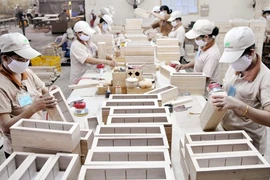
A handcrafted wood workshop in Van Ha commune, Hanoi’s outlying district of Dong Anh (Source:Vietnam Pictorial)
Hanoi (VNA) - Residents in Van Ha commune, Hanoi’s outlying district of Dong Anh are well-known for their craftsmanship and strong aesthetic sense. Traditional handicraft wood products made in the commune are an ingenious combination of wood and craftsmanship.
Each product is a result of hard labour and meticulous artwork made by artisans.
The woodworking process includes handling carefully selected raw wood, removing the outside layer of wood, which is the young and easy-to-rot wood on the outside of the tree. Later, the remaining wood is boiled for many days to prevent them from warping, which is caused by the hot and humid weather conditions in Vietnam.
 There are a diverse range of wooden handicrafts, including paintings, statues, furniture and decorations (Photo: Vietnam Pictorial)
There are a diverse range of wooden handicrafts, including paintings, statues, furniture and decorations (Photo: Vietnam Pictorial)Wood cutting is a very complicated process. The wood cutter must have experience and skills in product analysis. Big wood blocks will be cut into several pieces depending on the size of desired products, like a chef preparing ingredients and adding spices to a dish. It is an important stage to save input materials because precious raw wood is expensive and makes up a large portion of the product cost. If one does not know how to cut the wood, the product will look bad and fail to meet the desired quality.
After being processed, wood pieces will be chiseled and carved with decorative patterns such as legendary animals (dragons, qilin, turtles, Fenghuang), or trees and flowers (plums, pine, bamboo, chrysanthemums) to make products look beautiful.
The pieces will later be assembled together, flattened, smoothened and polished. After that, they will be rubbed with sandpaper two times, both wet and dry. The measurements of a product should be in in odd numbers rather than even numbers.
Each village in Van Ha commune specialises in a stage in the product making process. Thiet Binh village, which specialises in the buying and selling of wood materials from Laos and the Central Highlands regions to make cabinets and chairs. Thiet Ung village specialises in making Buddha statues while Ha Khe village produces mirror frameworks. The elderly and children rub sandpaper, young people and men chisel and carve, and women trim to make finished products.
Popular products of Thiet Ung village are statues of Phuc-Loc-Tho (Deities of Blessing, Prosperity and Longevity), pictures of the Four Noble Ones and statues of animals like pigs and dragons. These products are sold in most provinces nationwide and exported to some countries like China, Japan and the Republic of Korea (RoK).
Co Chau – Ha Khe village specialises in producing household furniture such as beds, wardrobes, tables and chairs. Ong hamlet in Thiet Ung and Dom hamlet in Van Diem have preserved the skills of carving handicrafts and making statues. Thiet Ung is proud to have veteran artisans like Dao Van Boi, Dong The Hien, Dong Van Ngoc, Dong Van Huy, Do Van Mien, Nguyen Van Luu, among others.
 Processing raw materials at a wooden handicraft workshop in Van Ha commune (Photo: Vietnam Pictorial)
Processing raw materials at a wooden handicraft workshop in Van Ha commune (Photo: Vietnam Pictorial)Today, several households spent about 400-600 million VND on buying machinery to chisel bars faster. When travelling around this area, it is not only the sound of hand-chisels that you hear, but of industrial machines to reduce labour costs too. When the chiseling step is completed, products will be trimmed to create clearer lines.
To make products free from termites, workshops will hire old women to work part-time with a daily wage of 200,000 – 300,000 VND to rub products with wet and dry sandpapers. Finally, the products will be covered with a layer of oil before being delivered to customers./.





























